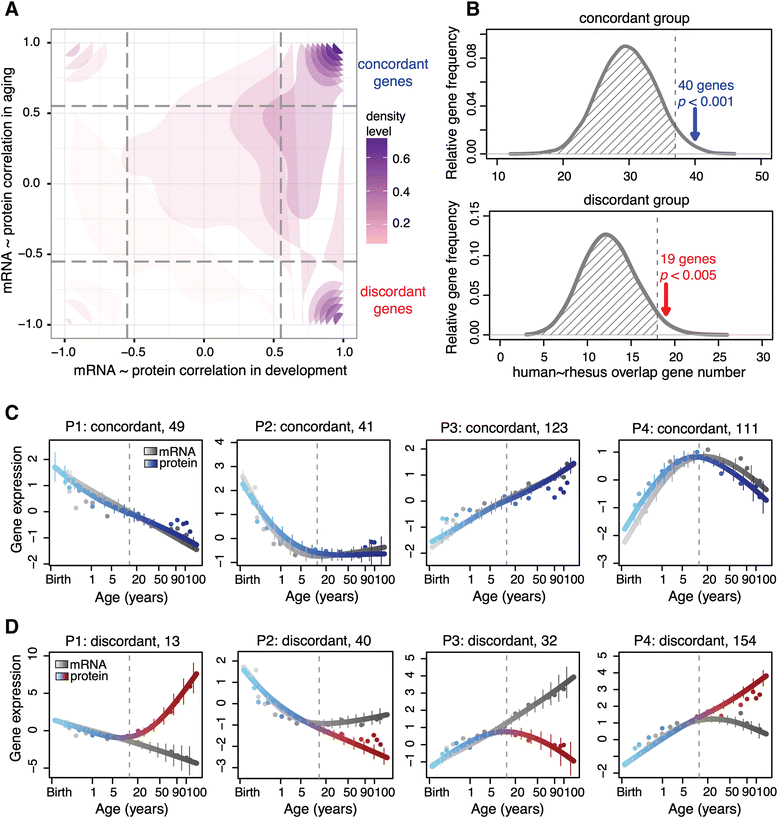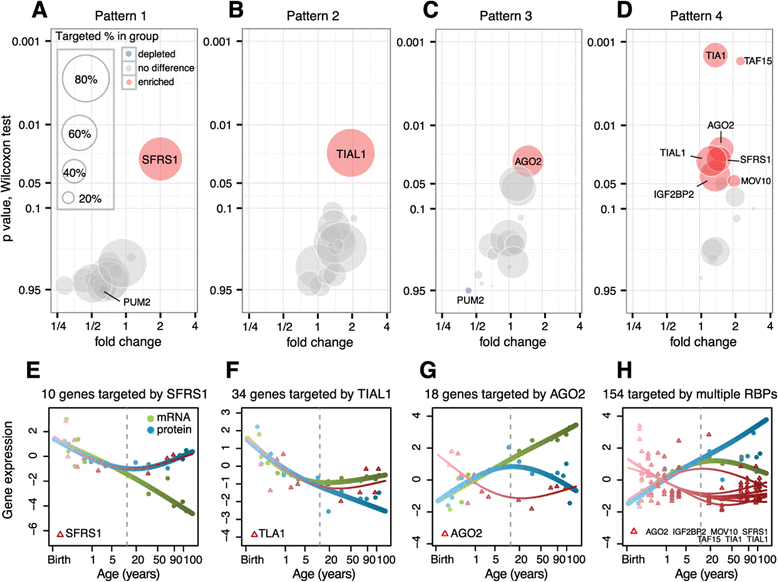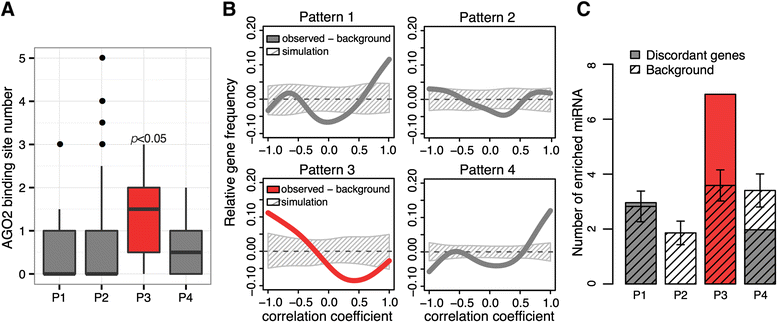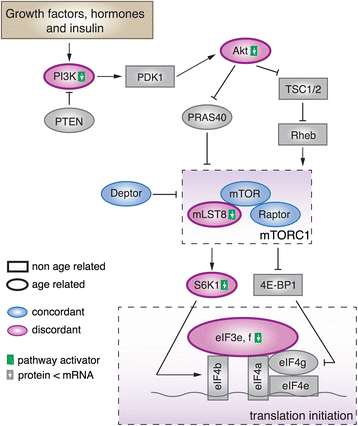Transcript and protein expression decoupling reveals RNA binding proteins and miRNAs as potential modulators of human aging
- PMID: 25853883
- PMCID: PMC4375924
- DOI: 10.1186/s13059-015-0608-2
Transcript and protein expression decoupling reveals RNA binding proteins and miRNAs as potential modulators of human aging
Abstract
Background: In studies of development and aging, the expression of many genes has been shown to undergo drastic changes at mRNA and protein levels. The connection between mRNA and protein expression level changes, as well as the role of posttranscriptional regulation in controlling expression level changes in postnatal development and aging, remains largely unexplored.
Results: Here, we survey mRNA and protein expression changes in the prefrontal cortex of humans and rhesus macaques over developmental and aging intervals of both species' lifespans. We find substantial decoupling of mRNA and protein expression levels in aging, but not in development. Genes showing increased mRNA/protein disparity in primate brain aging form expression patterns conserved between humans and macaques and are enriched in specific functions involving mammalian target of rapamycin (mTOR) signaling, mitochondrial function and neurodegeneration. Mechanistically, aging-dependent mRNA/protein expression decoupling could be linked to a specific set of RNA binding proteins and, to a lesser extent, to specific microRNAs.
Conclusions: Increased decoupling of mRNA and protein expression profiles observed in human and macaque brain aging results in specific co-expression profiles composed of genes with shared functions and shared regulatory signals linked to specific posttranscriptional regulators. Genes targeted and predicted to be targeted by the aging-dependent posttranscriptional regulation are associated with biological processes known to play important roles in aging and lifespan extension. These results indicate the potential importance of posttranscriptional regulation in modulating aging-dependent changes in humans and other species.
Figures





Similar articles
-
Molecular aging in human prefrontal cortex is selective and continuous throughout adult life.Biol Psychiatry. 2005 Mar 1;57(5):549-58. doi: 10.1016/j.biopsych.2004.10.034. Biol Psychiatry. 2005. PMID: 15737671
-
Stress-associated H3K4 methylation accumulates during postnatal development and aging of rhesus macaque brain.Aging Cell. 2012 Dec;11(6):1055-64. doi: 10.1111/acel.12007. Epub 2012 Oct 18. Aging Cell. 2012. PMID: 22978322
-
MicroRNA, mRNA, and protein expression link development and aging in human and macaque brain.Genome Res. 2010 Sep;20(9):1207-18. doi: 10.1101/gr.106849.110. Epub 2010 Jul 20. Genome Res. 2010. PMID: 20647238 Free PMC article.
-
MitomiRs in human inflamm-aging: a hypothesis involving miR-181a, miR-34a and miR-146a.Exp Gerontol. 2014 Aug;56:154-63. doi: 10.1016/j.exger.2014.03.002. Epub 2014 Mar 7. Exp Gerontol. 2014. PMID: 24607549 Review.
-
Competition and collaboration between RNA-binding proteins and microRNAs.Wiley Interdiscip Rev RNA. 2014 Jan-Feb;5(1):69-86. doi: 10.1002/wrna.1197. Epub 2013 Oct 7. Wiley Interdiscip Rev RNA. 2014. PMID: 24124109 Review.
Cited by
-
Proteogenomic Analysis of Surgically Resected Lung Adenocarcinoma.J Thorac Oncol. 2018 Oct;13(10):1519-1529. doi: 10.1016/j.jtho.2018.06.025. Epub 2018 Jul 11. J Thorac Oncol. 2018. PMID: 30017829 Free PMC article.
-
SliceIt: A genome-wide resource and visualization tool to design CRISPR/Cas9 screens for editing protein-RNA interaction sites in the human genome.Methods. 2020 Jun 1;178:104-113. doi: 10.1016/j.ymeth.2019.09.004. Epub 2019 Sep 5. Methods. 2020. PMID: 31494246 Free PMC article.
-
Decoupling of mRNA and Protein Expression in Aging Brains Reveals the Age-Dependent Adaptation of Specific Gene Subsets.Cells. 2023 Feb 14;12(4):615. doi: 10.3390/cells12040615. Cells. 2023. PMID: 36831282 Free PMC article.
-
A post-transcriptional regulatory landscape of aging in the female mouse hippocampus.Front Aging Neurosci. 2023 Mar 24;15:1119873. doi: 10.3389/fnagi.2023.1119873. eCollection 2023. Front Aging Neurosci. 2023. PMID: 37122377 Free PMC article.
-
Native-state proteomics of Parvalbumin interneurons identifies unique molecular signatures and vulnerabilities to early Alzheimer's pathology.Nat Commun. 2024 Apr 1;15(1):2823. doi: 10.1038/s41467-024-47028-7. Nat Commun. 2024. PMID: 38561349 Free PMC article.
References
-
- van Kouwenhove M, Kedde M, Agami R. MicroRNA regulation by RNA-binding proteins and its implications for cancer. Nat Rev Cancer. 2011;11:644–56. - PubMed
-
- Siegel G, Saba R, Schratt G. microRNAs in neurons: manifold regulatory roles at the synapse. Curr Opin Genet Dev. 2011;21:491–7. - PubMed
-
- Janga SC, Vallabhaneni S. MicroRNAs as post-transcriptional machines and their interplay with cellular networks. Adv Exp Med Biol. 2011;722:59–74. - PubMed
Publication types
MeSH terms
Substances
LinkOut - more resources
Full Text Sources
Other Literature Sources
Medical
Miscellaneous

